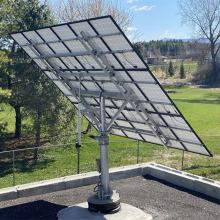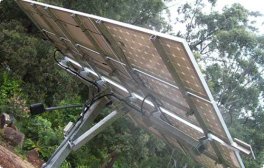Maximizing the amount of sunshine hitting your solar panels is the aim of every solar owner. That’s why solar trackers are so appealing.
Solar trackers work in a similar way to sunflowers. A sunflower slowly turns its face to follow the sun, and a solar tracker does the same – allowing the panels to always face the sun.
Up until recently, solar trackers were only available for ground-mounted solar panels. Mostly, you’d mostly see them on mega-watt scale solar farms.
Now solar trackers are available for residential solar panel systems, but the costs are very high.
The question is: are solar trackers worth it for household solar panel installations?
On this blog:
- What are solar trackers?
- How do solar trackers work?
- Two main types of solar trackers
- How much more power do you get with solar trackers?
- How much do solar trackers cost?
- Pros and cons of solar trackers for residential use
- Summing up
What are solar trackers?


A solar tracker is a device that follows the sun as it moves across the sky.
With a household solar installation, the solar tracking equipment would be fastened to the solar racking system on your roof.
From there, solar panels are attached to solar trackers, allowing each panel to rotate to follow the sun. This allows each panel to produce more solar electricity for you to use. That’s because solar panels work best when they are directly facing the sun.
How do solar trackers work?
A solar tracker can operate either passively or actively.
A passive solar tracker works on simple gas canisters that get heavier as they heat up. An active solar tracker relies on a motor, gears, and a controller, so it’s a bit more expensive.
Two main types of solar trackers
There are two main types of solar trackers: single- and dual-axis.
A single-axis solar tracker tracks the sun from east to west. It rotates on a single point, moving all the panels in a row in unison.
Dual-axis trackers rotate on both the X and Y axes, capturing the full sunlight potential of the sun.
The advantages of single-axis trackers are:
- less complex – and therefore less expensive
- structurally more rigid – so less likely to be damaged during high winds.
The disadvantages of single axis trackers are:
- Produce slightly less solar electricity than dual-axis trackers
The advantages of dual axis trackers are:
- Allow the solar panels to capture more direct sunlight and produce more electricity
- Particularly effective at more southerly latitudes in Australia.
The disadvantages of dual axis trackers are:
- More complex and expensive
- More moving parts and, as a result, more likely to break down
- Increase in output compared to single-axis trackers is only around 4-5 per cent, making the higher price tag hard to justify
How much more power do you get with solar trackers?
The effectiveness of solar trackers depends on your latitude and the climate at your location.
In the southern hemisphere, solar trackers work best in more southerly locations. In Australia, solar trackers work best in Tasmania, and are least effective in Darwin.
In Melbourne, a solar tracker can increase the performance of a solar panel by around 19 to 23 per cent compared to a conventional solar panel system, depending on whether you have a single or dual axis tracker.
Output gains vary depending on the time of year, with the summer months the best because the sun travels across a much wider arc of the sky.
In terms of actual kilowatt hours, you can expect 1kW of solar panels on a fixed mount to generate around 1,234 kilowatt hours a year. This increases to 1,468 kilowatt hours if the 1kW solar panel system is attached to a single-axis tracker and 1,520 kilowatt hours if it’s fixed to a dual axis tracker.
| Solar panels mounted directly on roof for 1kW system | Single-axis tracker for 1kW system | Dual-axis tracker for 1kW system | |
|---|---|---|---|
| Approx. kilowatt hours produced each year in Melbourne. | 1,234 kWh | 1,468 kWh | 1,520 kWh |
What this boils down to is that you get an additional 286 kWh per year for each 1kW of solar panels installed with dual axis trackers vs a conventional solar system mounted directly on your roof.
How much do solar trackers cost?
Be prepared for a bit of a shock; solar trackers are super expensive!
A quality 6.6kW solar system will set you back around $8,000 in Melbourne before state government rebates are applied.
Add solar trackers, and your upfront cost will more than double to around $20,000 before state government rebates.
That’s the real reason why you don’t see many – if any – solar trackers on houses. It’s much more cost effective to add more solar panels to get the additional output.
Pros and cons of solar trackers?
Here’s the list of pros and cons of solar trackers versus conventional fixed solar panel systems.
Pros of solar trackers:
- More direct sunlight hitting the solar panels
- More power output per panel compared to fixed solar arrays
Cons
- Very expensive with low financial return
- Made up of moving parts, so more likely to break
- Higher maintenance costs
- Work best on a flat roof, or ground-mounted
- Structurally less rigid than permanent mounts – so can be vulnerable to storm damage
Are they worth the investment?
For most households, solar trackers are not worth the additional investment even though they produce more electricity.
In virtually all cases, you would be better off installing more solar panels than installing solar trackers on your home. That’s because solar panels are cheaper than ever before, and solar trackers are still incredibly expensive.
For example, on a 6.6kW solar system you’d get an extra 1,880 kilowatt-hours of solar electricity a year by installing a dual-axis solar tracker. Assuming you can use 60 per cent of this extra energy in your home and export the rest to the grid, you’d be better off by around $325 a year. If your trackers last 10 years without need for maintenance (which would be good going), you would be ahead by around $3,250; nowhere near the additional $12,000 price tag you paid for the system.
Conclusion
Right now, solar trackers are not worth it for residential solar panel installations in Australia.
Of course, this may change when prices drop. But for the time being, the best solution for solar households is to mount the panels directly onto your roof – or put them on a tilt system if your roof is pitched at 10⁰ or less.
Get in touch
If you’d like more advice on solar panels or a quote, get in touch.
Specialized Solar & Electrical is one of Victoria’s most highly regarded quality solar retailers, accredited by the Clean Energy Council for solar panel and battery installations. We’re also a fully registered electrical contractor; something that’s less usual in the solar industry. Given that solar is all about electricity, we reckon that extra level of electrical accreditation is super important given that electrical safety is paramount for any solar installation.











